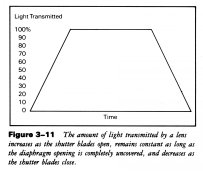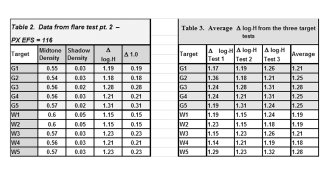Bill, I don't think that's the right conclusion to come to based on a broken shutter. It's more like the rationalizations of apologetics. From where I stand, this is another example of the problems with Zone System testing. I believe fixing the shutter or having the shutter calibrated would be preferable. What if the shutter is off only with the higher shutter speeds? What about large format that uses multiple lenses each having their own shutter? Should the photographer do a speed test at every f/stop and shutter speed combination for every lens? Wouldn't you think it might also be easier to identify problems like bad shutters if there is confidence in the value of the film speed?
Even if the shutter is working properly, it doesn't necessarily transmit the same amount of light at every shutter speed.
View attachment 114819
I still think the relationship can be mathematically defined. But we have to clearly say that we assume correct shutter speeds or include shutter speed data in the definition. We cannot tell someone what their Zone System EI is given a film's ASA/ISO if their shutter speeds are incorrect. Exactly as you say, it's the problem with traditional Zone System Tests that multiple factors are tossed in.
Now I can see a valid argument in favor of traditional Zone System tests for a photography student facing an immediate assignment: Calibrate using traditional Zone System and then use the results to take a planned photograph. I think the traditional Zone System combined tests can give a student immediate results. The instructor can give grades based on the steps the student took and the results they obtained, and it may be different than expected but student can still get credit for doing the work properly, even if they come out with an EI that nobody else in the class got (except the other students who shared that camera).
But an amateur, who may want to make use of the results over a longer time frame, and with a variety of cameras, may be better served with separate film and equipment tests.
Other equipment must be assumed to be properly functioning too, for example RobC mentioned light meters. Generally light meters are the most reliable piece of a photographer's equipment, but what about my vintage Weston Master II whose emulsion speed scale is not ASA/ISO? What about the meters calibrated for mercury cells that are no longer available and photographers naturally are tempted to use whatever cell fits (Alkaline cells where the meter was meant for Mercury)?
So we must assume the equipment is properly functioning, or we need to test for the equipment separately.
I still hold the position that these tests are better broken out, but I enjoy the logic of the argument for a combined test to help a student achieve immediate success, even if those results glossed over a lot of variables.
Shutters are pretty awful.
We have already heard stories of malfunctioning shutters from David Allen and the photographer I was helping. I've got another story:
I used three factors once to test one of my shutters (a Retina I): Electronically-measured time, Angular time (rotation of a 78-RPM record player), Gray card density measurements. No one factor was useful across all shutter speeds. Electronic times were best at slow speeds. Gray card density measurements were best at high speeds.
At the airport in San Francisco on the way to Connecticut to take a photo of StoneNYC, I discovered the mainspring of that camera had broken. The end where it hooks onto the rotating ring had become wedged and then the next time I cocked the shutter, it sheared off. I was familiar with the assembly because I had done a CLA... So I took it apart with rudimentary tools (I think I had a sewing needle), bent another loop of spring material into a hook and reassembled the camera. It held together for that trip, I got the picture of StoneNYC.
I used EI 250 which I determined sensitometrically as 400 and I shifted to 250 according to the relationship outlined in this thread so that I could use Zone System metering.
I used Zone System metering to read the light side of his face and placed it on Zone VI.
I used a modern meter (Sekonic TwinMate modified to support Zone System metering), which takes currently available batteries. After determining the required shutter speed, I selected a shutter speed (I think I selected 1/2 second) which I believe by sound was approximately one second.
The shot came out fine.







 then that might say a lot about the respective film speeds
then that might say a lot about the respective film speeds


